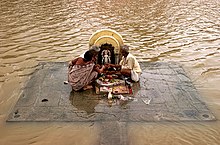Sadhana
Sadhana ( Sanskrit , साधन, sādhana , from the root 'sadh', 'going straight to a goal, being successful') denotes a spiritual discipline that is undertaken in order to achieve a certain spiritual goal. These goals can be to attain enlightenment, to attain liberation ( moksha ) from the cycle of samsara, to attain nirvana , or to attain the blessings and love of a deity as is the case in the bhakti tradition. Those who practice sadhana are called sadhak or sadhaka . The seldom used female form of it is sadhika . Even a sadhu who renounces the world submits to a sadhana. The term is used in different meanings in Buddhism and Hinduism .


Sadhana in Hinduism
Sadhana can be practiced by both an individual and a group. Sadhana includes regular exercises such as meditations , chanting bhajans , reciting mantras , worshiping deities through puja, and as a whole requires adopting a special mindset in order to achieve one's goal. In Hinduism it is traditionally a guru who guides the disciple on the path of sadhana. According to the teachings of most yoga masters, regular exercises such as Asana , Pranayama , Dhyana , Japa , Karma - yoga and regular reading of inspiring scriptures are necessary to achieve the goal of God-realization.
Sadhana in Buddhist Vajrayana
Sadhana is a ritual meditation practice in Tibetan Buddhism . Sadhana texts give precise instructions for pictorial meditation on one or more deities: In sadhana the meditator unites with the object of his meditation, the deity. It makes no difference whether this happens in a complex, predetermined or spontaneous way. On the one hand, a mantra or a thought may be sufficient to bring about the union, on the other hand it can be a longer ritual that includes purifications, recitations, imagination, offerings, mantras and mudras .
Examples of traditional works are Sadhanamala or Guhyasamayasadhanamala . The descriptions of deities contained therein are also important for iconographic determination.
All tantras contain sadhanas, for example the third chapter of the first book of the Hevajra tantra .
Structure of the sadhanas
A sadhana begins with a welcoming worship (mangala) of the deity and preparatory exercises.
Preparatory exercises include choosing the place, sitting down in a suitable sitting posture ( asana ), rituals to cleanse and protect the place and the meditator and the generation of the Bodhisattva spirit. The main part is divided into the pictorial creation of the deity and the vision of the highest reality, the void.
The final part consists of wishful prayers, good fortune and blessings.
literature
- Benoytosh Bhattacharyya: Sadhanamala . 2 volumes. Baroda, 1925 & 1928.
- Benoytosh Bhattacharyya: The Indian Buddhist Iconography. Based on the Sadhanamala and Other Cognate Tantric Texts of Rituals . Cosmo Publications, New Delhi 1985.
- Elizabeth English: Vajrayoginî. Her Visualizations, Rituals, and Forms. A Study of the Cult of Vajrayoginî in India . Wisdom Publications, Boston 2001, ISBN 0-86171-329-X .
- Yogi Bhajan: Sadhana Manual. Kundalini Yoga as taught by Yogi Bhajan . Khalsa Distributors, Amsterdam, ISBN 978-3-9805039-7-6 .
- Shuddhananda Bharati: The Secrets of Sadhana , Éditions ASSA, L'Auberson 2012, ISBN 978-2-940393-46-6 .

